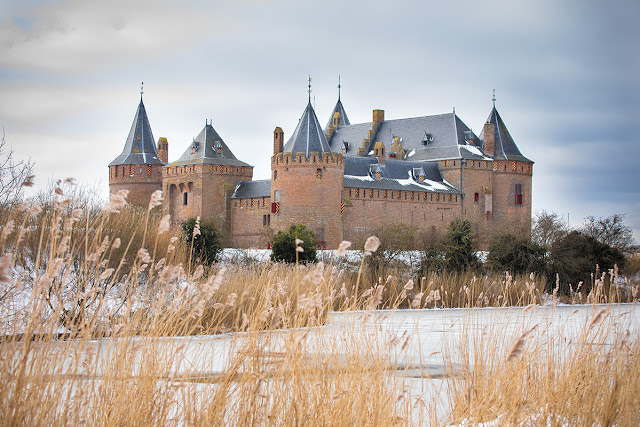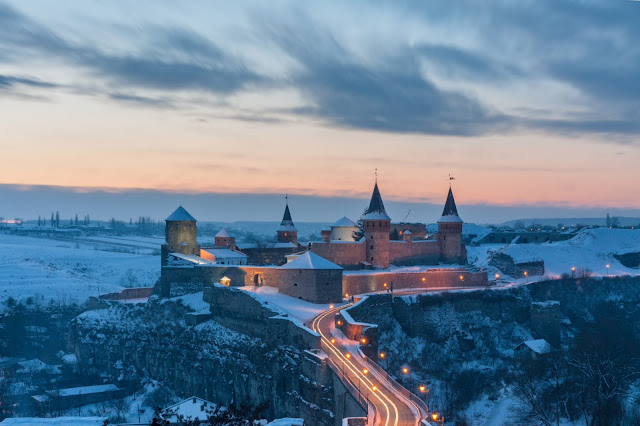23. Peles Castle, Romania During the construction phase, Queen Elisabeth of Wied wrote in her journal: "Italians were masons, Romanians were building terraces, Greeks worked in stone, Germans were carpenters. Engineers were Polish and the stone carvers were Czech."
24. Rocca imperiale, Italy Included among I Borghi più belli d'Italia (the most beautiful villages of Italy), the village's highlight is a majestic 13th-century castle situated at the very top.
26. Castel Nuovo, Italy Also known as Maschio Angioino, its imposing size and scenic location, with Mount Vesuvius in the background, make this castle one of Naples's main architectural landmarks.
27. Bojnice Castle, Slovakia This magnificent 12th-century Romanesque castle, featuring Gothic and Renaissance elements, was owned by Hungarian kings and nobles until the Treaty of Trianon (1920) made the territory part of Czechoslovakia.
28. Karlštejn Castle, Czech Republic This Gothic castle, founded in 1348 by King Charles IV, served as a secure haven for the Imperial Regalia, the Bohemian Crown Jewels, holy relics, and other royal treasures.
29. Craigievar Castle,1626, Scotland
Craigievar Castle is a harled castle or fortified country house 6 miles (9.7 km) south of Alford, Aberdeenshire, Scotland. It was the seat of Clan Sempill, and the Forbes family resided here for 350 years until 1963, when the property was sold to the National Trust for Scotland by the 19th Lord Sempill.
30. Hohenwerfen Castle, Werfen, Austria, 1075 & 1078 by Archbishop Gebhard of Salzburg
Hohenwerfen Castle is a medieval rock castle, situated at an altitude of 623 metres (2,044 ft), on a 155-metre (509 ft) rock pillar overlooking the Austrian market town of Werfen in the Salzach valley, approximately 40 kilometres (25 mi) south of Salzburg. The fortress is surrounded by the Berchtesgaden Alps and the adjacent Tennen Mountains. Hohenwerfen is a "sister" of Hohensalzburg Fortress, both built by the Archbishops of Salzburg in the 11th century.
32. Castel Nuovo in Naples, Italy
Castel Nuovo, often called Maschio Angioino, is a medieval castle located in front of Piazza Municipio and the city hall (Palazzo San Giacomo) in central Naples, Campania, Italy. Its scenic location and imposing size makes the castle, first erected in 1279, one of the main architectural landmarks of the city. It was a royal seat for kings of Naples, Aragon and Spain until 1815.
33. Castel Sant'Elmo, Naples, Italy
Castel Sant'Elmo is a medieval fortress located on Vomero Hill adjacent to the Certosa di San Martino, overlooking Naples, Italy. The name "Sant'Elmo" derives from a former 10th-century church dedicated to Sant'Erasmo. Documents date a structure at the site from 1275, from the era of Charles of Anjou. Known originally as Belforte, it was likely a fortified residence, surrounded by walls, its entrance gate marked by two turrets. In 1329, using designs by the Sienese architect Tino da Camaino, king Robert of Naples enlarged the fortress.
The Moszna Castle is a historic castle and palace located in the small village of Moszna, in southwestern Poland. Situated approximately 30 kilometres (19 mi) south of the regional capital Opole, between the towns of Prudnik and Krapkowice, the residence is an excellent example of romantic fairy-tale and eclectic architecture.
The Castle of the Teutonic Order in Malbork, commonly known as Malbork Castle, is a brick gothic castle complex located in the town of Malbork, Poland, built in 13th and significantly expanded in 14th century. It is the largest castle in the world measured by land area and a UNESCO World Heritage Site.
36. Muiderslot, Muiden, Netherlands
Muiden Castle is a castle in the Netherlands, located at the mouth of the Vecht river, some 15 kilometers southeast of Amsterdam, in Muiden, where it flows into what used to be the Zuiderzee. It is one of the better known castles in the Netherlands and featured in many television shows set in the Middle Ages.
37. Kasteel (Kasteel de Haar), Haarzuilens, Utrecht, Netherlands
De Haar Castle (Dutch: Kasteel de Haar) is located outside Utrecht, Netherlands. It is the largest castle in The Netherlands. The oldest historical record of a building at the location of the current castle dates to 1391. In that year, the De Haar family received the castle and the surrounding lands as a fiefdom from Hendrik van Woerden. The castle remained in the ownership of the De Haar family until 1440, when the last male heir died childless.
38. Kasteel Hoensbroek, Limburg, Netherlands
Hoensbroek Castle (Dutch: Kasteel Hoensbroek) or Gebrook Castle (Dutch: Gebrookhoes) is one of the largest castles in the Netherlands. It is situated in Hoensbroek, a town in the province of Limburg. This imposing watercastle is known as 'the most lordly stronghold between Rhine and Meuse'. The oldest part of the castle, notably the tall round tower, dates from around 1360, when it was built by Herman Hoen.
39. Predjama castle, Slovenia
Predjama Castle is a Renaissance castle built within a cave mouth in south-central Slovenia, in the historical region of Inner Carniola. The castle was first mentioned in 1274 with the German name Luegg, when the Patriarch of Aquileia built the castle in Gothic style. The castle was built under a natural rocky arch high in the stone wall to make access to it difficult. It was later acquired and expanded by the Luegg noble family, also known as the Knights of Adelsberg (the German name of Postojna).
Kamianets-Podilskyi Castle is a former Ruthenian-Lithuanian castle and a later three-part Polish fortress located in the historic city of Kamianets-Podilskyi, Ukraine, in the historic region of Podilia in the western part of the country. Its name is attributed to the root word 'kamin', from the Slavic word for 'stone'.
Historical accounts date Kamianets-Podilskyi Castle to the early 14th century, although recent archaeological evidence has proved human existence in the area back to the 12th or 13th century. Initially built to protect the bridge connecting the city with the mainland, the castle sits on top of a peninsula carved out by the winding Smotrych River, forming a natural defense system for Kamianets-Podilskyi's historic Old Town neighborhood.
















,%20Haarzuilens,%20Utrecht,%20Netherlands.jpeg)





Комментариев нет:
Отправить комментарий